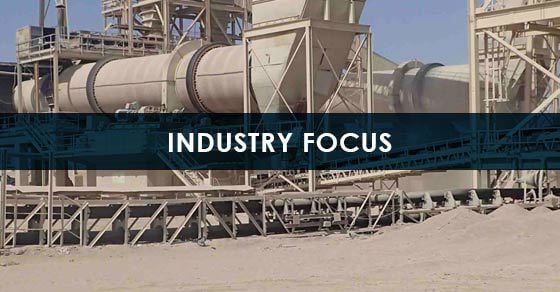As emission regulations continue to tighten around every industry in an effort to fight climate change, producers in the potash industry have increasingly been focusing their efforts on cutting emissions. And with the potash drying process accounting for a significant portion of the sector’s emissions, many are looking at where they can reduce emissions in this critical processing step.
An experienced rotary dryer manufacturer can optimize dryer design – both in new and in existing systems – to minimize emissions, allowing producers to meet both production and emissions goals.
As the industry’s preferred potash dryer supplier, we’ve put together the guide below on design considerations that influence emissions production.
Potash Dryer Design Considerations That Affect Emissions
Several aspects of rotary dryer design can be configured to minimize potential emissions. The most important factors are listed here.
Burner Selection
The burner is typically the first and most obvious aspect of design considered in reducing emissions. While a number of burners are available, some are better than others when it comes to emissions. In selecting one for a potash plant, producers should opt for a burner that minimizes nitrous oxides (NOx) and carbon monoxide (CO) – the two greenhouse gases of most concern in drying potash.
Fuel Selection
While fuel options are sometimes limited, if the situation allows, producers should select a cleaner fuel, such as natural gas, to help minimize emissions.
Combustion Chamber Design
The combustion chamber is another area that provides an opportunity to lower emissions.
Through optimized combustion chamber design, producers can achieve lower fuel consumption and reduce excess emissions by promoting a more complete mixing and combustion of the fuel.
Further, by keeping the product from contact with the flame, material exiting the dryer is cooler, decreasing the cooling requirement and its associated emissions.
Knockout Chamber
The incorporation of a knockout chamber, or oversize discharge hood, minimizes entrainment and particle carryover which could otherwise contribute to particulate emissions in the exhaust gases. This design also increases overall system efficiency by allowing for a greater air flow velocity and in turn, a smaller-diameter drum.
Heat Recovery
Waste heat recovery systems can be incorporated into the drying system to recover excess heat for use elsewhere in the plant, reducing the need to generate additional heat.
Similarly, waste heat recovered from other sources could be utilized to improve dryer efficiency by preheating the combustion and dilution air going into the burner.
Control System
A control system can also help to minimize emissions. Control and data collection systems give operators a window into process efficiency, allowing them to adjust variables in real time to optimize the process and minimize energy waste.
Seals
The right rotary dryer seal can also contribute to more efficient dryer operation. Seals minimize excess fuel use, because they prevent ambient air from leaking into the system.
Reliability
A reliable dryer might not initially come to mind in considering how to reduce emissions, but it does make an important difference.
Since dryers use more energy at startup, dryers plagued by frequent start-ups and shutdowns due to mechanical failures or process upsets use more energy and produce higher emissions than a dryer that simply runs consistently.
Efficient design also minimizes emissions associated with having to reprocess material.
VFD
A variable frequency drive, or VFD, can be incorporated to minimize power surges and excess energy use during start-up. The use of a VFD has other benefits as well, including reduced motor wear and minimized mechanical shock.
Flight Design & Pattern
Flights, or material lifters, can also have a significant influence on drying efficiency and associated emissions. Flight design and pattern should be optimized according to the specific characteristics of the potash source to be dried. This will help to prevent under drying and reprocessing, as well as overdrying.
Optimizing Existing Potash Dryer Systems
Those looking to optimize their existing potash dryer for reduced emissions have options as well. A number of adjustments and modifications can be made to existing systems to improve their overall efficiency and reduce unnecessary emissions.
Process Audit
Producers looking to minimize emissions in their existing system should enlist the help of a rotary dryer expert to conduct a process audit.
A rotary dryer process audit can identify inefficiencies and areas of improvement that not only affect emissions, but that can also benefit product quality, throughput, and other aspects of the production line.
Annual Inspection
Part of keeping a rotary dryer efficient and minimizing emissions is to keep it in proper working order. For this reason, an annual inspection is a vital tool in maintaining the rotary dryer.
Annual inspections may be conducted by the OEM, or a qualified service technician and should include a thorough review of the dryer both inside and out. This will help to catch potential problems early so they can be addressed and provides valuable benchmark data.
By keeping the dryer optimal condition, producers can avoid the emissions associated with an underperforming system, excessive mechanical stress, and other process inefficiencies.
Conclusion
The increasing focus on limiting emissions from the potash sector continues to tighten. By working with an experienced rotary dryer manufacturer, however, potash producers can be confident that their drying system is designed to minimize emissions and maximize performance and reliability.
FEECO is the potash industry’s preferred provider of custom rotary dryers, each designed and optimized to suit the unique characteristics of the specific source of potash to be dried. In addition, our Customer Service Team offers a variety of services to not only keep potash dryers running their best, but to optimize their performance. For more information on our potash processing equipment and services, contact us today!



